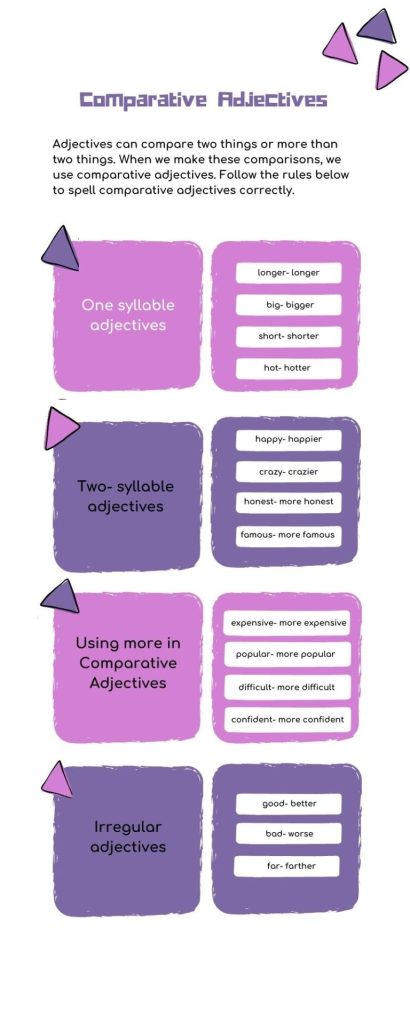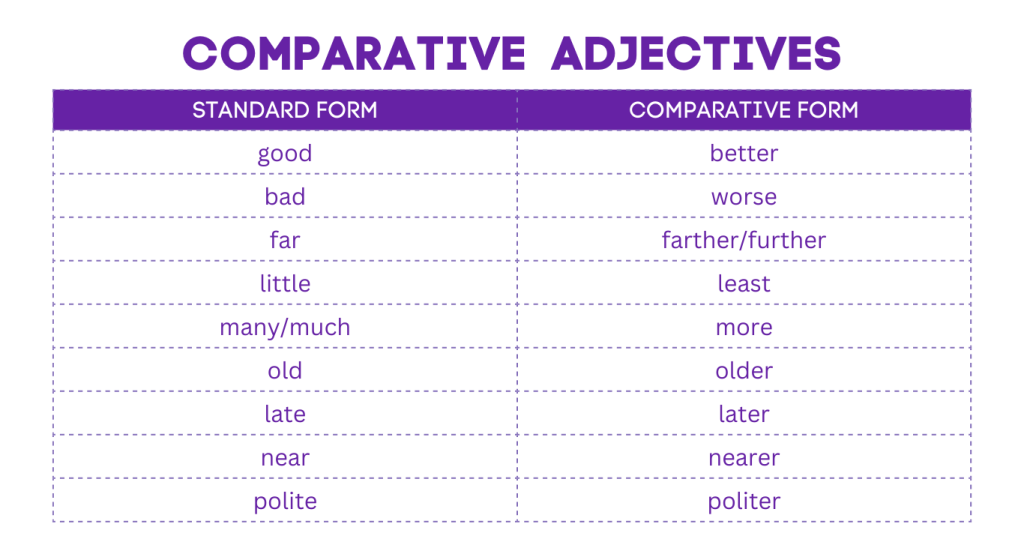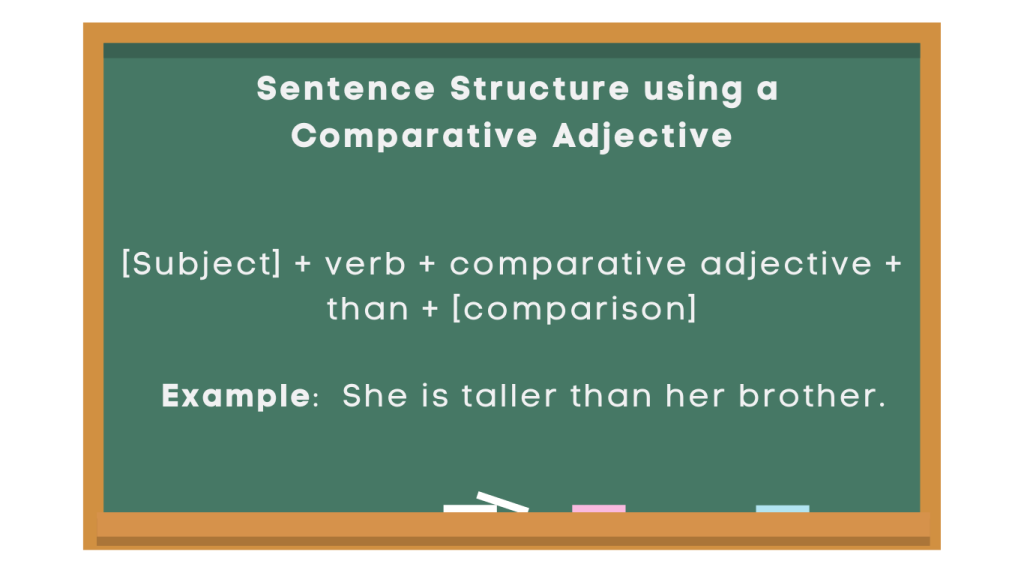Comparative Adjectives: Examples and Usage Tips
Table of Contents
Introduction
Comparative Adjectives
Comparative adjectives are an integral part of language, enabling us to compare and contrast the qualities of different entities. Let’s delve into the world of comparative adjectives, explore their usage, and gain insights into effectively incorporating them into our communication.
Method
Rules for Forming Comparative Adjectives
Comparative adjectives are formed by adding -er to the end of short adjectives, and by using ‘more’ before longer adjectives. Understanding the rules for their formation is essential for using comparative adjectives accurately.
One-syllable Adjectives
When dealing with most one-syllable adjectives, you can easily form the comparative by adding the suffix “-er” to the end of the word without altering the spelling.
For example,
- “tall” becomes “taller”
- “fast” becomes “faster”
However, for words ending with -e or a consonant-vowel-consonant, there are different rules.
One-syllable Adjectives ending in –e
For one-syllable adjectives which end in -e, we just add an -r at the end of the word.
For example,
- “brave” becomes “braver”
- “safe” becomes “safer”
One-syllable Adjectives ending in consonant-vowel-consonant
When dealing with one-syllable adjectives that end in a consonant-vowel-consonant pattern, such as “hot” or “sad,” it’s important to remember a specific rule. We need to double the last consonant and then add “-er” to form the comparative.
- “hot” becomes “hotter”
- “sad” becomes “sadder”
Two-syllable Adjectives ending in –er, –ow, or –le
For two-syllable adjectives that end in specific patterns like “-er” or “-ow,” there’s a straightforward rule for forming the comparative. For adjectives ending in “-er” or “-ow,” simply add “-er” to the end without altering the spelling. Similarly, if an adjective ends in “-le,” you can simply add “-r” to form the comparative.
For example,
- “gentle” becomes “gentler”
- “noble” becomes “nobler”
- “idle” becomes “idler”
One- or two-syllable adjectives ending in –y
If an one-or-two-syllable adjective ends in a -y, then we replace the y with an i and then add -er to the word.
- “noisy” becomes “noisier”
- “busy” becomes “busier

Using More in Comparative Adjectives
When considering when to use “more” with comparative adjectives, it’s important to understand a few guidelines. Generally, adjectives with three or more syllables always use “more” before them. Additionally, two-syllable adjectives except for those ending in -er, -ow, -le, or -y also require “more” before them. For example, “beautiful” becomes “more beautiful” when comparing. Exceptions include two-syllable adjectives with specific endings like -er, -ow, -le, and -y, which follow different spelling rules for comparison. It’s worth noting that using “more” with comparative adjectives is akin to using “less.” You can simply add “less” before any adjective without needing to alter the spelling.

Examples
Example 1: The elephant is bigger than the lion.
Example 2: This car is faster than the previous model.
Example 3: She is more intelligent than her classmates. 12 more such examples of comparative adjective
Example 4: The mountain is taller than the hill.
Example 5: His house is larger than mine.
Example 6: The new laptop is lighter than the old one.
Example 7: This novel is more interesting than the one I read last week.
Example 8: My sister is taller than me.
Example 9: Today’s weather is warmer than yesterday’s.
Example 10: The blue dress is prettier than the green one.
Example 11: His speech was clearer than hers.
Example 12: The river is wider than the stream.
Example 13: This cake is sweeter than the one I had yesterday.
Example 14: The movie was scarier than I expected.
Example 15: The new restaurant is busier than the one across the street.
These examples illustrate the use of comparative adjectives in sentences to compare the qualities of different entities. By employing comparative adjectives, we can effectively convey the differences in attributes and express degrees of comparison.
Quiz
Tips and Tricks
1. Practice with Short Adjectives
Tip: Use -er to form comparative adjectives for short words.
Example: Fast -> Faster, Big -> Bigger
2. Utilize ‘More’ for Longer Adjectives
Tip: Use ‘more’ before longer adjectives to form comparative adjectives.
Example: Intelligent -> More intelligent, Beautiful -> More beautiful
3. Understand Degrees of Comparison
Tip: Familiarize yourself with the concepts of positive, comparative, and superlative degrees of adjectives to use them accurately in sentences.
4. Seek Feedback
Tip: Practice using comparative adjectives in writing and speech, and seek feedback from peers or mentors to improve your proficiency.
5. Read and Analyze Examples
Tip: Read various texts and analyze how comparative adjectives are used to express comparisons, and incorporate similar structures in your own communication.
Real life application
Real-Life Applications of Comparative Adjectives
Scenario: Car Shopping Dilemma
When comparing two cars for purchase, the use of comparative adjectives becomes crucial in expressing the differences in their features, performance, and pricing. By utilizing comparative adjectives, one can make informed decisions and effectively communicate preferences.
Scenario: Restaurant Review Comparisons
When writing restaurant reviews, the use of comparative adjectives allows for the comparison of different dining experiences, highlighting the strengths and weaknesses of each establishment. This aids readers in making informed choices based on the comparative analysis provided.
Scenario: Travel Destination Selection
Comparative adjectives are instrumental in comparing and contrasting various travel destinations, enabling individuals to make informed decisions based on factors such as climate, attractions, and cultural experiences.
FAQ's
Like? Share it with your friends

